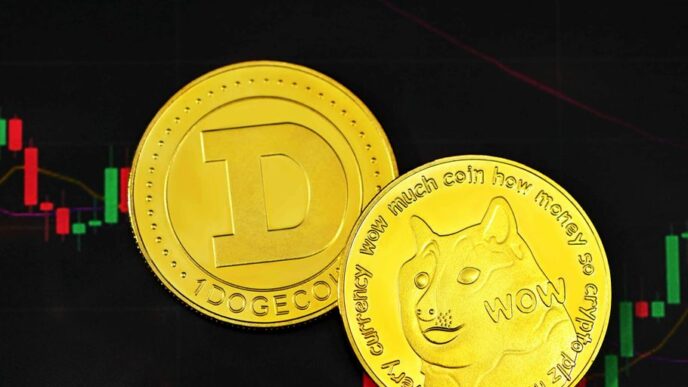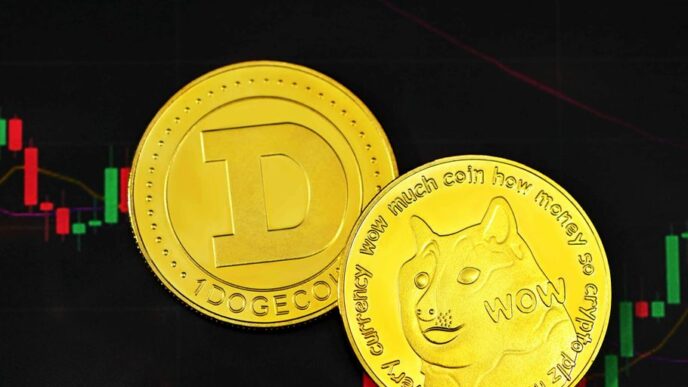The world of cryptocurrency has grown from a niche interest to a global financial phenomenon, captivating the attention of investors, regulators, and the general public alike. As digital currencies like Bitcoin, Ethereum, and others continue to rise in prominence, the market’s volatility and the surrounding regulatory landscape are in constant flux. This article provides an in-depth exploration of the current trends in the crypto market, with a particular focus on major cryptocurrencies like Bitcoin and the significant regulatory news shaping the future of this dynamic industry.
The Rise of Major Cryptocurrencies: Bitcoin and Beyond
1. Bitcoin: The Pioneer and Market Leader
Bitcoin, the first and most well-known cryptocurrency, has remained the dominant player in the crypto market since its inception in 2009 by the pseudonymous figure Satoshi Nakamoto. Often referred to as “digital gold,” Bitcoin’s primary appeal lies in its decentralized nature, limited supply (capped at 21 million coins), and its role as a hedge against inflation and currency devaluation.
Market Performance: As of mid-2024, Bitcoin continues to hold the largest market capitalization among cryptocurrencies, consistently accounting for approximately 40-50% of the total crypto market. Despite its volatility, Bitcoin’s value has seen significant growth, with prices reaching new all-time highs in late 2023, driven by increasing institutional adoption and macroeconomic factors such as inflation fears and geopolitical tensions.
Institutional Adoption: One of the key drivers of Bitcoin’s growth in recent years has been the increasing interest from institutional investors. Major companies such as Tesla, MicroStrategy, and Square have added Bitcoin to their balance sheets, while investment firms like BlackRock and Fidelity have launched Bitcoin-related products, including exchange-traded funds (ETFs). This institutional adoption has helped to legitimize Bitcoin as a mainstream asset class, contributing to its price appreciation and stability.
Bitcoin as Digital Gold: The narrative of Bitcoin as “digital gold” has gained traction, particularly in light of the global economic uncertainties that have characterized the early 2020s. With traditional safe-haven assets like gold and government bonds offering lower returns, Bitcoin has emerged as an alternative store of value for both retail and institutional investors. Its decentralized nature and resistance to government intervention have made it an attractive hedge against inflation and currency depreciation, especially in countries with unstable financial systems.
2. Ethereum: The Foundation of Decentralized Finance (DeFi)
Ethereum, launched in 2015 by Vitalik Buterin, is the second-largest cryptocurrency by market capitalization and is often described as the “world computer” due to its ability to support smart contracts and decentralized applications (dApps). Unlike Bitcoin, which is primarily a store of value, Ethereum serves as a platform for building decentralized applications across various sectors, including finance, gaming, and supply chain management.
Ethereum 2.0 and Proof of Stake: One of the most significant developments in the Ethereum ecosystem is the ongoing transition to Ethereum 2.0, which began with the launch of the Beacon Chain in December 2020. Ethereum 2.0 aims to address the scalability and energy efficiency issues associated with the network by transitioning from a proof-of-work (PoW) to a proof-of-stake (PoS) consensus mechanism. As of 2024, Ethereum’s full transition to PoS has significantly reduced its energy consumption, increased transaction throughput, and enhanced security, making it more attractive to both developers and investors.
Decentralized Finance (DeFi): Ethereum is the backbone of the rapidly growing decentralized finance (DeFi) sector, which leverages blockchain technology to recreate traditional financial services—such as lending, borrowing, and trading—without intermediaries. As of mid-2024, the total value locked (TVL) in DeFi protocols exceeds $150 billion, with Ethereum-based platforms like Uniswap, Aave, and MakerDAO leading the charge. This growth in DeFi has driven demand for Ethereum and its native token, Ether (ETH), further solidifying its position as a critical infrastructure in the crypto ecosystem.
Non-Fungible Tokens (NFTs): Another major trend on the Ethereum network is the explosion of non-fungible tokens (NFTs), unique digital assets representing ownership of virtual or physical items. NFTs have gained mainstream attention through the sale of digital art, collectibles, and virtual real estate, with marketplaces like OpenSea and Rarible facilitating billions of dollars in transactions. The NFT market’s growth has also contributed to the demand for Ether, as most NFTs are minted and traded on the Ethereum blockchain.
3. Emerging Cryptocurrencies and Blockchain Innovations
While Bitcoin and Ethereum continue to dominate the crypto market, several other cryptocurrencies have gained traction due to their innovative use cases, technological advancements, or community-driven growth.
Cardano (ADA): Cardano, founded by Ethereum co-founder Charles Hoskinson, is a blockchain platform focused on scalability, interoperability, and sustainability. Its proof-of-stake consensus mechanism and focus on academic research have garnered significant attention, particularly in regions like Africa, where Cardano is being used for various real-world applications, such as identity verification and supply chain management.
Solana (SOL): Solana is a high-performance blockchain known for its fast transaction speeds and low fees, making it a popular choice for decentralized applications and crypto projects. Solana’s unique proof-of-history (PoH) consensus mechanism allows it to process thousands of transactions per second, positioning it as a competitor to Ethereum in the race to build scalable blockchain networks.
Polkadot (DOT): Polkadot, developed by Ethereum co-founder Gavin Wood, aims to create a multi-chain ecosystem where different blockchains can interact and share information. This interoperability has made Polkadot an attractive platform for developers looking to build cross-chain applications, and its innovative technology has attracted a growing community of users and investors.
Binance Coin (BNB): Binance Coin, the native token of the Binance cryptocurrency exchange, has evolved beyond a mere utility token to become a key player in the crypto ecosystem. BNB is used for transaction fees on the Binance Smart Chain (BSC), a blockchain that supports smart contracts and decentralized applications. BSC has gained popularity as an alternative to Ethereum due to its lower fees and faster transaction times, leading to a surge in BNB’s value.
Regulatory Developments: Shaping the Future of Crypto
As the cryptocurrency market continues to grow, it has attracted the attention of regulators worldwide. Governments and financial institutions are grappling with how to regulate an industry that challenges traditional financial systems while also offering innovative solutions to economic and technological challenges.
1. United States: Regulatory Clarity and Challenges
The United States, home to some of the largest crypto exchanges and blockchain companies, has taken a cautious yet increasingly proactive approach to regulating the cryptocurrency market.
SEC and CFTC Involvement: The U.S. Securities and Exchange Commission (SEC) and the Commodity Futures Trading Commission (CFTC) are the primary regulatory bodies overseeing the crypto market. The SEC has been particularly focused on determining whether certain cryptocurrencies qualify as securities under the Howey Test, which has led to legal actions against several crypto projects. One of the most notable cases is the SEC’s lawsuit against Ripple Labs, the company behind the XRP token, over the alleged sale of unregistered securities. The outcome of this case is expected to set a precedent for how cryptocurrencies are classified and regulated in the U.S.
Cryptocurrency Taxation: The Internal Revenue Service (IRS) has also ramped up its efforts to ensure that cryptocurrency transactions are properly reported and taxed. In 2023, the IRS introduced new reporting requirements for crypto exchanges and wallet providers, mandating them to report transactions exceeding $10,000. Additionally, the Infrastructure Investment and Jobs Act, passed in 2021, included provisions to strengthen the IRS’s ability to enforce crypto tax compliance.
Stablecoins and CBDCs: Stablecoins, cryptocurrencies pegged to traditional fiat currencies, have come under scrutiny due to concerns about their potential impact on financial stability. In 2022, the President’s Working Group on Financial Markets released a report calling for comprehensive regulation of stablecoins, including requirements for issuers to maintain adequate reserves and comply with anti-money laundering (AML) laws. At the same time, the U.S. Federal Reserve has been exploring the development of a central bank digital currency (CBDC), commonly referred to as the digital dollar. The introduction of a CBDC could have significant implications for the crypto market, potentially increasing competition for private stablecoins while providing a government-backed alternative to traditional cryptocurrencies.
2. Europe: The Regulatory Landscape and MiCA Framework
Europe has emerged as a leader in developing a comprehensive regulatory framework for the cryptocurrency market, balancing the need for innovation with consumer protection and financial stability.
Markets in Crypto-Assets (MiCA) Regulation: In 2022, the European Union (EU) reached a landmark agreement on the Markets in Crypto-Assets (MiCA) regulation, which aims to provide a harmonized legal framework for crypto assets across the EU. MiCA covers a wide range of topics, including the issuance and trading of crypto assets, the role of intermediaries, and the protection of consumers. The regulation is expected to provide greater legal clarity for businesses and investors while also enhancing the EU’s ability to combat money laundering and other illicit activities in the crypto space.
Environmental Concerns and PoW Ban Debate: The environmental impact of proof-of-work (PoW) mining, particularly for Bitcoin, has been a contentious issue in Europe. Several EU member states, including Sweden and Germany, have raised concerns about the energy consumption associated with PoW mining, leading to calls for a ban on the practice. While the EU ultimately decided against a ban, the debate has prompted further discussions about the sustainability of blockchain technologies and the need for greener alternatives.
Crypto-Friendly Jurisdictions: Despite the regulatory challenges, several European countries have positioned themselves as crypto-friendly jurisdictions, attracting businesses and investors. Malta, for example, has established itself as a hub for blockchain and cryptocurrency companies, offering a favorable regulatory environment and a robust legal framework. Switzerland, known for its “Crypto Valley” in Zug, continues to be a leading destination for crypto startups, thanks to its supportive regulatory approach and strong tradition of financial privacy.
3. Asia: A Mixed Bag of Regulations and Innovation
Asia, home to some of the world’s largest cryptocurrency markets, presents a diverse regulatory landscape, with approaches ranging from outright bans to proactive support for blockchain innovation.
China’s Crypto Crackdown: China has taken a hardline stance against cryptocurrencies, banning all crypto-related activities, including trading, mining, and initial coin offerings (ICOs). The Chinese government has cited concerns about financial stability, fraud, and energy consumption as reasons for the crackdown. Despite the ban, China remains a major player in the blockchain space, with the government actively promoting the development of blockchain technology and the digital yuan, its own CBDC.
Japan: A Proactive Approach: Japan has been a pioneer in crypto regulation, being one of the first countries to recognize Bitcoin as legal tender and regulate cryptocurrency exchanges. The Japanese Financial Services Agency (FSA) has implemented strict regulations to protect consumers and prevent money laundering, while also fostering innovation in the crypto sector. Japan’s proactive approach has helped establish it as a leading market for crypto trading and blockchain development.
South Korea: Balancing Regulation and Growth: South Korea has taken a balanced approach to crypto regulation, focusing on consumer protection and market integrity while supporting the growth of the blockchain industry. The government has implemented strict AML and KYC (know your customer) requirements for crypto exchanges, and in 2021, introduced a capital gains tax on cryptocurrency profits. At the same time, South Korea is investing in blockchain technology, with plans to integrate it into various sectors, including finance, logistics, and public services.
4. Emerging Markets: Opportunities and Challenges
Emerging markets are increasingly embracing cryptocurrencies as a solution to various economic challenges, from hyperinflation to financial exclusion. However, these markets also face unique regulatory hurdles and risks.
Latin America: In Latin America, cryptocurrencies have gained popularity as a hedge against inflation and currency devaluation, particularly in countries like Venezuela and Argentina. In 2021, El Salvador made history by becoming the first country to adopt Bitcoin as legal tender, a move that has sparked both excitement and controversy. While proponents argue that Bitcoin can provide financial inclusion and reduce remittance costs, critics warn of the risks associated with volatility and the potential for money laundering.
Africa: Africa is another region where cryptocurrencies are gaining traction, driven by the need for financial inclusion and the inefficiencies of traditional banking systems. Nigeria, Kenya, and South Africa are leading the way in crypto adoption, with a growing number of people using cryptocurrencies for remittances, savings, and online transactions. However, regulatory uncertainty and the lack of infrastructure remain significant challenges to the widespread adoption of cryptocurrencies in Africa.
Southeast Asia: In Southeast Asia, countries like Singapore and Thailand are emerging as crypto hubs, offering favorable regulatory environments and attracting investment from both local and international companies. Singapore, in particular, has established itself as a global fintech hub, with the Monetary Authority of Singapore (MAS) taking a progressive approach to crypto regulation. Thailand has also implemented comprehensive regulations for cryptocurrencies, including licensing requirements for exchanges and ICOs.
The Future of the Crypto Market: Trends and Predictions
As the crypto market continues to evolve, several key trends are likely to shape its future, from technological innovations to regulatory developments and the broader integration of cryptocurrencies into the global financial system.
1. The Rise of Decentralized Finance (DeFi)
Decentralized finance (DeFi) has emerged as one of the most transformative trends in the crypto market, offering a wide range of financial services without the need for traditional intermediaries. DeFi platforms enable users to lend, borrow, trade, and earn interest on their crypto assets, all through smart contracts on blockchain networks.
Growth and Challenges: The DeFi sector has seen explosive growth, with the total value locked (TVL) in DeFi protocols surpassing $150 billion in 2024. However, the rapid expansion of DeFi has also raised concerns about security, regulatory compliance, and market manipulation. High-profile hacks and exploits, such as the $600 million Poly Network hack in 2021, have highlighted the risks associated with DeFi platforms, underscoring the need for improved security measures and regulatory oversight.
Interoperability and Cross-Chain Solutions: As the DeFi ecosystem continues to grow, the need for interoperability between different blockchain networks has become increasingly important. Cross-chain solutions, such as Polkadot and Cosmos, aim to facilitate the seamless transfer of assets and data between different blockchains, enabling greater liquidity and efficiency in the DeFi market.
2. Central Bank Digital Currencies (CBDCs) and Stablecoins
The development of central bank digital currencies (CBDCs) and the growth of stablecoins are set to have a profound impact on the crypto market and the broader financial system.
CBDCs: Central banks around the world are exploring the development of digital versions of their national currencies, with the goal of enhancing financial inclusion, improving payment systems, and maintaining monetary sovereignty in the face of the growing influence of cryptocurrencies. The People’s Bank of China (PBOC) has already launched pilot programs for the digital yuan, while the European Central Bank (ECB) and the U.S. Federal Reserve are in the research and development phases for their own digital currencies. The widespread adoption of CBDCs could reshape the global financial landscape, potentially reducing the demand for private cryptocurrencies while also introducing new forms of competition.
Stablecoins: Stablecoins, which are pegged to traditional fiat currencies, have become an essential component of the crypto market, offering a stable store of value and a reliable medium of exchange. Tether (USDT), USD Coin (USDC), and Binance USD (BUSD) are among the most widely used stablecoins, facilitating billions of dollars in daily transactions. However, the rapid growth of stablecoins has raised concerns among regulators about their potential impact on financial stability and monetary policy. In response, several countries are exploring the regulation of stablecoin issuers, including requirements for transparency, reserve management, and compliance with AML laws.
3. The Integration of Cryptocurrencies into Traditional Finance
As cryptocurrencies gain mainstream acceptance, their integration into traditional finance is accelerating, with major financial institutions offering crypto-related products and services to their clients.
Crypto Custody and Asset Management: Major banks and financial institutions, such as JPMorgan, Goldman Sachs, and Fidelity, have begun offering crypto custody and asset management services to their clients, enabling institutional investors to gain exposure to digital assets. These services provide secure storage solutions and investment products, such as Bitcoin ETFs and crypto index funds, catering to the growing demand for crypto investments.
Tokenization of Assets: The tokenization of real-world assets, such as real estate, art, and commodities, is another emerging trend in the crypto market. Tokenization involves creating digital representations of physical assets on a blockchain, enabling fractional ownership, increased liquidity, and more efficient trading. This trend has the potential to revolutionize traditional asset markets, making them more accessible and transparent.
Payment Integration: Cryptocurrencies are increasingly being integrated into payment systems, with major companies like PayPal, Visa, and Mastercard allowing customers to buy, sell, and spend cryptocurrencies. These developments are bridging the gap between the crypto and traditional financial systems, making it easier for consumers and businesses to transact in digital currencies.
4. The Environmental Impact and Sustainable Blockchain Solutions
The environmental impact of cryptocurrencies, particularly those using proof-of-work (PoW) mining, has become a major concern, leading to the exploration of more sustainable blockchain solutions.
Energy Consumption: Bitcoin and other PoW-based cryptocurrencies have been criticized for their high energy consumption, with Bitcoin mining alone estimated to consume more electricity than entire countries like Argentina or the Netherlands. This has sparked a debate about the sustainability of PoW mining and the need for greener alternatives.
Proof of Stake (PoS) and Other Consensus Mechanisms: In response to environmental concerns, many blockchain networks are transitioning to proof-of-stake (PoS) or other energy-efficient consensus mechanisms. Ethereum’s transition to PoS with Ethereum 2.0 is a prime example, reducing its energy consumption by over 99%. Other networks, such as Solana and Cardano, have adopted PoS from the outset, offering more sustainable alternatives to PoW-based blockchains.
Carbon Offsetting and Renewable Energy: Some cryptocurrency projects are exploring carbon offsetting and the use of renewable energy to reduce their environmental impact. Companies like Ripple and Chia Network have committed to becoming carbon-neutral, while Bitcoin miners in regions like Texas and Norway are increasingly using renewable energy sources to power their operations.
Conclusion
The cryptocurrency market is undergoing a period of rapid evolution, driven by technological innovation, increasing institutional adoption, and a complex and evolving regulatory landscape. Major cryptocurrencies like Bitcoin and Ethereum continue to dominate the market, while emerging cryptocurrencies and blockchain projects are pushing the boundaries of what is possible with decentralized technology.
Regulatory developments around the world are shaping the future of the crypto market, with governments seeking to balance innovation with consumer protection and financial stability. The rise of decentralized finance (DeFi), the development of central bank digital currencies (CBDCs), and the integration of cryptocurrencies into traditional finance are just some of the trends that will define the future of this dynamic industry.
As the market continues to mature, the need for sustainable and scalable blockchain solutions will become increasingly important, with environmental concerns driving the exploration of greener consensus mechanisms and energy-efficient technologies.
In this rapidly changing landscape, the cryptocurrency market offers both opportunities and challenges for investors, developers, and regulators alike. The future of the crypto market will depend on the ability of stakeholders to navigate these challenges and harness the transformative potential of blockchain technology to create a more inclusive, transparent, and sustainable financial system.












